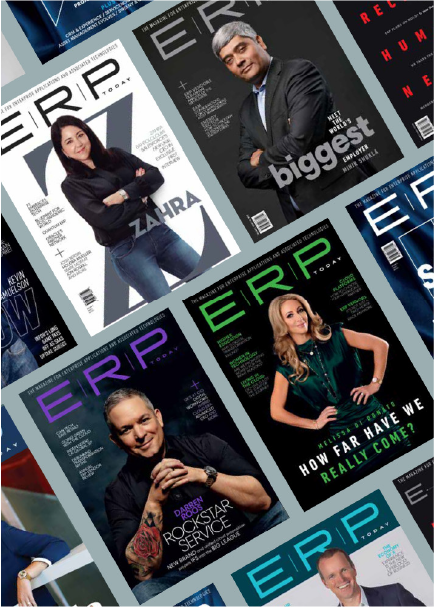 Enterprise resource planning (ERP) systems have always promised control, structure, and efficiency. But if you ask Georg Glantschnig, VP of Dynamics 365 AI ERP at Microsoft, that’s not enough anymore. Today’s ERP, he argues, must evolve into something intelligent, autonomous, and user-adaptive—capable of learning from its users, not just serving them.
Enterprise resource planning (ERP) systems have always promised control, structure, and efficiency. But if you ask Georg Glantschnig, VP of Dynamics 365 AI ERP at Microsoft, that’s not enough anymore. Today’s ERP, he argues, must evolve into something intelligent, autonomous, and user-adaptive—capable of learning from its users, not just serving them.
“Practicality is the new aspiration,” Glantschnig says. “ERP can no longer just support a business process. It needs to run it.”
At a glance, that might sound like yet another AI-era platitude. But under the surface, Microsoft is staking out a radically different ERP future—one powered by agentic AI, consumption-based economics, and a design philosophy that favors human adaptability over system rigidity.
For decades, ERP platforms have remained largely consistent in one critical way: users input data into forms, and systems output reports. That model, Glantschnig says, is crumbling.
“We’re moving into an AI-first architecture,” he explains, “where agents—not just users—interact with ERP systems.”
These agents are not just assistive bots. They are increasingly autonomous actors capable of executing tasks on behalf of departments, customers, and even entire business units. Think demand forecasting, invoice reconciliation, or workforce scheduling—without human initiation.
Microsoft’s roadmap includes a three-tier framework:
- Exposing granular services like invoicing or order-taking via APIs for agent communication
- Creating an agent development platform, enabling Microsoft, partners, and customers to build their own
- Redesigning the user experience, so people interact primarily with agents rather than systems.
In other words, the ERP of tomorrow is less like a cockpit and more like a team of autonomous copilots. For Microsoft, this isn’t just a tech evolution. It’s a business model transformation. The traditional user-based licensing structure begins to break down when agents replace users in core workflows. That opens the door to consumption-based and outcome-based pricing—a model already familiar to Azure customers, but new to ERP.
At the same time, Glantschnig is quick to differentiate Microsoft from rivals that merely retrofit AI into legacy software.
“Some ERP vendors just took their on-prem stack and hosted it in the cloud. That’s not cloud-native—and it’s definitely not AI-native,” he says. “We’ve reimagined how software is delivered, tested, maintained, and even monetized.”
That reimagination is also reflected in Microsoft’s “Power of One” stack—a cohesive suite of cloud infrastructure (Azure), low-code extensibility (Power Platform), data fabrics (Microsoft Fabric), and productivity tools (Office, Teams). For Dynamics 365 customers, that ecosystem delivers modularity without fragmentation.
“Everything works together, but it’s also composable. You can choose what you need without sacrificing integration,” Glantsching says.
But autonomy requires trust—and in ERP, trust is hard-earned. Customers want control, visibility, and assurance that AI won’t take their processes off the rails. Glantschnig says Microsoft is meeting that demand with features like:
- Explainability and audit trails
- Human-in-the-loop control
- Governance for agent creation and management
“It’s like when GPS first came out,” he analogizes. “We all kept paper maps in the glove compartment. Now, we trust the system. ERP will follow that same trajectory.”
Value realization used to mean successful deployment. Not anymore.
“Success isn’t go-live. It’s continuous business value,” says Glantschnig. “And that value has to be shared between Microsoft, our partners, and the customer.”
This mindset is shaping new programs like FastTrack, which helps customers implement, monitor, and extract value from Dynamics 365 continuously. It also informs Microsoft’s future pricing evolution: as agents shoulder more of the workload, licensing may shift from user-based to outcome- or consumption-based.
Looking two to three years ahead, Glantschnig’s vision is simple—but transformative: “ERP should adapt to the user—not the other way around.”
That means no more training manuals. No more endless customizations. Just a system that evolves by observing how it’s used—and anticipates what comes next. If Microsoft succeeds in delivering this vision, Dynamics 365 won’t just be the practical choice—it will be the preferred one. And for the first time in a generation, ERP may actually live up to its promise: not just managing the business, but making it smarter, faster, and more human.
What this means for ERP Insiders
ERP is evolving toward intelligence—are you ready? Some reports say that by 2026, 75% of ERP implementations will include embedded AI features to support autonomous decision-making. Microsoft Dynamics 365 is betting on this shift, enabling ERP systems to not just assist, but execute operational tasks—such as forecasting, invoicing, and workforce scheduling—without human initiation. This evolution from system-of-record to system-of-action transforms what IT leaders must prioritize: not just integrations, but agent orchestration, governance, and explainability. Dynamics 365’s agentic AI framework supports autonomous workflows while maintaining human-in-the-loop control. Companies like Majans (a CPG manufacturer) have already reported double-digit improvements in operational efficiency using AI-enabled Dynamics modules. Business leaders should assess their readiness not just for implementation, but for a future where ERP decisions are made by algorithms, not analysts. To capture this value, organizations need to invest in data quality, trust frameworks, and AI literacy across finance, supply chain, and operations.
ERP licensing is moving from users to outcomes. Traditional ERP licensing has revolved around users and modules. But as Dynamics 365 evolves into an AI-first, agent-driven platform, Microsoft is paving the way for consumption-based and outcome-based pricing models—a shift already familiar to Azure customers. This has major implications for procurement, budgeting, and value realization strategies. Leaders must begin forecasting value not just by the number of seats, but by measurable operational outcomes, such as cycle-time reduction, forecasting accuracy, or invoice throughput. Microsoft’s FastTrack program helps customers track these metrics, enabling continuous value assessment post-deployment. One global electronics manufacturer reported a 30% reduction in manual journal entries within six months of deploying Dynamics 365 Finance with Copilot. CIOs should challenge vendors on how licensing aligns to business value and ensures that future ERP roadmaps include flexibility for automation-led workflows that no longer fit legacy pricing models. Ignoring this shift could lead to overpayment—or underutilized innovation.
Consider the full-stack advantage of Microsoft. By operating Dynamics 365, Power Platform, Office 365, and Azure as a cohesive suite, organizations benefit from deep native integration across business applications, infrastructure, and collaboration tools. Microsoft’s Common Data Model (CDM) and Dataverse enable consistent data definitions across services, reducing time spent on mapping, reconciling, or synchronizing data between siloed systems. This streamlines enterprise architecture and reduces total integration cost (TIC) by up to 40%. Microsoft’s full-stack approach uses a single identity and access model (via Azure Active Directory), enabling centralized role-based access control (RBAC), multifactor authentication (MFA), and compliance enforcement across data, apps, and infrastructure. Organizations benefit from 360-degree threat protection via Microsoft Defender, Purview (compliance & data governance), and Sentinel (SIEM). This reduces security management complexity and improves audit readiness across ERP, productivity, and custom apps—all governed in a unified compliance portal. And Microsoft’s full stack enables composability: organizations can modernize incrementally—adopting Dynamics 365 Sales or Finance modules without overhauling everything at once. Through Power Platform connectors, Azure Logic Apps, and REST APIs, enterprises can extend or integrate with best-of-breed or legacy systems while maintaining governance.






